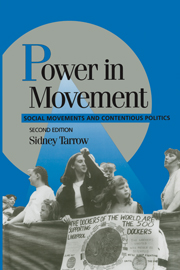Book contents
- Frontmatter
- Contents
- List of Figures
- Preface
- Acknowledgments
- Introduction
- 1 Contentious Politics and Social Movements
- PART 1 THE BIRTH OF THE MODERN SOCIAL MOVEMENT
- 2 Modular Collective Action
- 3 Print and Association
- 4 State Building and Social Movements
- PART II FROM CONTENTION TO SOCIAL MOVEMENTS
- PART III THE DYNAMICS OF MOVEMENT
- Conclusion: The Future of Social Movements
- Notes
- Sources
- Index
- CAMBRIDGE STUDIES IN COMPARATIVE POLITICS
3 - Print and Association
Published online by Cambridge University Press: 05 June 2012
- Frontmatter
- Contents
- List of Figures
- Preface
- Acknowledgments
- Introduction
- 1 Contentious Politics and Social Movements
- PART 1 THE BIRTH OF THE MODERN SOCIAL MOVEMENT
- 2 Modular Collective Action
- 3 Print and Association
- 4 State Building and Social Movements
- PART II FROM CONTENTION TO SOCIAL MOVEMENTS
- PART III THE DYNAMICS OF MOVEMENT
- Conclusion: The Future of Social Movements
- Notes
- Sources
- Index
- CAMBRIDGE STUDIES IN COMPARATIVE POLITICS
Summary
Social movements as we know them today began to appear in great numbers in the course of the eighteenth century. They drew their substance from structural changes that were associated with capitalism but preceded the industrial revolution. The major changes were the development of commercial print media and new models of association and socialization. These changes did not in themselves produce new grievances and conflicts but diffused ways of mounting claims that helped ordinary people to think of themselves as part of broader collectivities and on the same plane as their betters.
Printed books went back to the fifteenth century, but for a long time these were written in Latin, dealt mainly with religious subjects, and were inaccessible to ordinary people. This did not mean they were unimportant in spreading information – after all, the first political tracts were the religious books of the Protestant Reformation – but accessible publications had to await the spread of literacy and the lowering of the price of printed papers. Once that happened, popular newspapers and printed songs and pamphlets diffused images of ruler and aristocrat on the same sheets as bourgeois and plebeian, mechanic and tradesman, city dweller and rural notable.
New associational forms which escaped the tight corporate boundaries of estate societies first developed around church and commerce before being adopted by reading clubs, reform groups, and antislavery societies embodying moral purposes. Latent conflicts between people and their opponents were transposed into pamphlet wars, ribald songs, and scatological cartoons and prints.
- Type
- Chapter
- Information
- Power in MovementSocial Movements and Contentious Politics, pp. 43 - 53Publisher: Cambridge University PressPrint publication year: 1998

